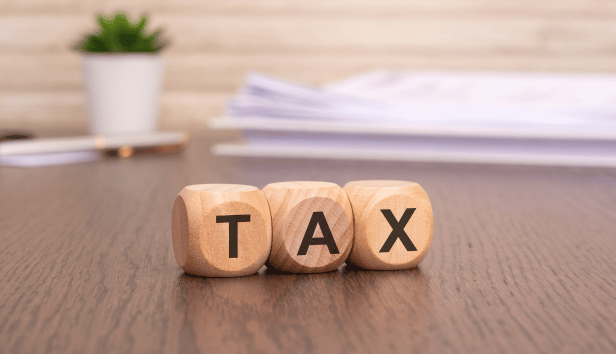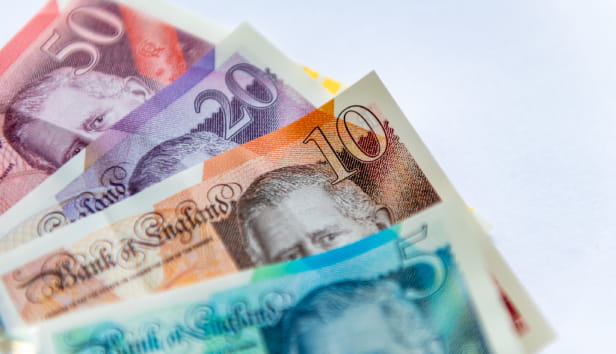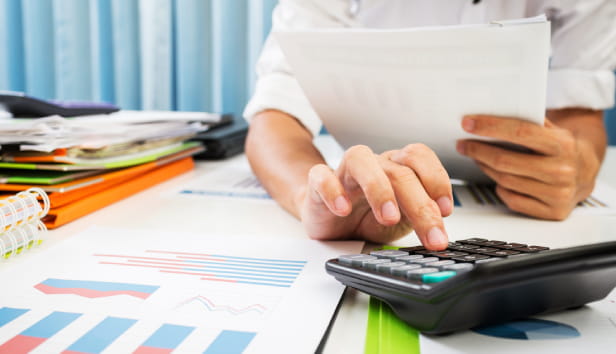/mature-couple-looking-at-taxes.jpg?la=en&h=650&w=1400&hash=5CFABEEDC751F26D56DD3E85749E3C36)
/mature-couple-looking-at-taxes.jpg?la=en&h=650&w=1400&hash=5CFABEEDC751F26D56DD3E85749E3C36)
/mature-couple-looking-at-taxes.jpg?la=en&h=650&w=1400&hash=5CFABEEDC751F26D56DD3E85749E3C36)
This article is for general guidance only and is not financial or professional advice. Any links are for your own information, and do not constitute any form of recommendation by Saga. You should not solely rely on this information to make any decisions, and consider seeking independent professional advice. All figures and information in this article are correct at the time of publishing, but laws, entitlements, tax treatments and allowances may change in the future.
Rising numbers of pensioners are finding that they need to pay income tax – including some of those who rely solely on the state pension.
The latest figures mean that the April 2026 state pension increase is set to take the full new state pension to just marginally below the personal allowance for income tax, meaning that only a tiny amount of additional taxable income is needed to push you into paying income tax. Some of those receiving the old state pension are already paying income tax, even if they don't have other income. And from 2027 everyone on the full new state pension is likely to be paying income tax.
We'll explain why the tax situation has changed and what you can do about it.
What’s on this page?
The state pension will increase in April 2026, almost certainly by an above-inflation amount of 4.8%.
The full new state pension is expected to be £12,547.60 per year. Weekly payments will rise from £230.25 to £241.30.
The personal allowance for income tax is £12,570. For tax purposes, HMRC assesses how much state pension you receive each year by calculating one week at the previous tax year’s rate of state pension and 51 weeks at the new rate. For the full new state pension, that means an annual taxable amount of £12,536.55 for 2026/27 – less than £35 below the tax threshold.
People who reached retirement age before April 2016 who are on the basic state pension will see their weekly income increase from £176.45 per week to £184.90. Some of those people will get additional state pension as well, although this component will only go up in line with inflation (3.8%).
The above-inflation uplift is thanks to the triple lock, which guarantees the state pension will go up every year by whichever of these figures is highest: 2.5%, average earnings growth for the previous May to July, or inflation in September. We now know that the highest of these was earnings growth for May to July 2025 at 4.8%.
The rise has sparked renewed debate about the future of the state pension and whether it is sustainable for national finances.
Helen Morrissey, head of retirement analysis at Hargreaves Lansdown, said: “The final increase is expected to be confirmed in November’s Budget and will be good news for cash-strapped pensioners who have seen their budgets severely squeezed in recent years.
“It will, however, add to the government’s ongoing headache of how to manage the swelling state pension bill. The commitment is to retain the triple lock until the end of the Parliament but after this point its future remains uncertain and we could see reform. We’ve also got the ongoing state pension age review, which could see the age at which we receive this important benefit creep up further and at a faster rate.”
Meanwhile, the personal allowance – the amount everyone can receive in income before they pay income tax on it – has been frozen at £12,570 a year since 2021, and is not due to increase until April 2028.
Some people who reached pension age before 6 April 2016 and have some additional state pension might already be above the personal allowance, just from their state pension, and will already be paying income tax on some of it.
The number of over-65s paying tax has already shot up in the last five years. According to the Institute for Fiscal Studies, a larger proportion of over-65s pay income tax (65%) compared with working-age adults (63%).
Following next April’s increase, the state pension will go up again by at least 2.5% in April 2027, which will take it firmly over the income tax threshold. That means income tax would need to be paid by more than 750,000 extra retired people, according to estimates by pension consultancy LCP.
This would remain the case even if income tax thresholds start to rise again in line with inflation – as is the government’s intention from April 2028 – because the state pension will rise in line with inflation at the very least.
It's important to note that tax will only be charged on the income that is above the threshold, not all your pension income.
Steve Webb, partner at LCP, said: “In most cases, the amounts involved will be relatively small, but the hassle of having to check the figures and deal with HMRC is something which will be unwelcome to most people of modest means in retirement.”
Rachel Vahey, head of public policy at AJ Bell, said: “This poses a significant conundrum for Rachel Reeves and the Treasury. If, as is likely, the triple lock sees the state pension increase above the personal allowance of £12,570 in April 2027 for the first time, then the government will come under increasing pressure to make a decision regarding either the personal allowance or whether it can sustain the triple lock as it has promised at least to the end of this parliament.
“Removing the freeze on the personal allowance would come at significant cost to the Treasury at a time when the chancellor’s fiscal headroom is already strained at best, while an overhaul of the triple lock would come with huge political risk before the next general election. Needless to say, it’s a headache Starmer and Reeves could do without ahead of a crucial Budget in November and economic and political pressure already beginning to swell both within the Labour Party and outside of it.”
/health-compare-page-1440x640-(1)/shutterstock_1448603999-(1).jpg?sc=max&mw=800&h=450&la=en&h=731&w=1300&hash=87B041E0CF8AB714E424C59EFF2928C2)
If your only income other than the state pension is interest you earn on your savings, the good news is that a little bit of savings interest won't immediately push you into paying income tax if you don't already. There are several reasons for this.
If your savings are held within an ISA, they don't count for tax purposes anyway.
If they're not within an ISA, don't panic. If your income from a pension or work is under £12,570, you get an additional £5,000 allowance for savings interest called the starter rate for savings. So you won't be pushed into paying income tax unless your savings interest is more than that.
If your income from pension or work is between £12,570 and £17,570, you'll start to pay some income tax, but you'll still benefit from some of the starter rate for savings. You lose £1 of the £5,000 starting rate for savings for each £1 you have in income (not including savings interest or dividends) above £12,570, and you lose it completely in you have more than £17,570 of income.
For example, if your income (from pensions or earnings) is £15,000, you would get a tax-free allowance on the first £2,570 of savings interest, plus the additional £1,000 personal savings allowance that all basic-rate taxpayers get.
If the state pension is your only income, then even though you may have a tax bill, you shouldn’t have to fill in a tax return. Instead you will need to go through a process known as ‘simple assessment’, where HMRC uses the information it has – about your state pension and any other income – to work out what you should have paid, and then writes to you with a tax demand after the end of each tax year.
Most retired people have a combination of the state pension and one or more other pensions, such as a workplace pension. In this case, tax is calculated on your total income from all sources, depending on which tax bracket you end up in.
Currently, in England, Wales and Northern Ireland the first £12,570 is tax-free. Basic rate tax at 20% is paid on income between £12,571 and £50,270. Between £50,271 and £125,140 tax is payable at 40%. Income over £125,140 is taxed at 45%. Scotland has its own income tax bands.
Any income you take from your private pension is taxed in the same way as earned income. Tax will be deducted from your pension income by your pension provider before it’s paid to you, using Pay as You Earn (PAYE). If you have a private pension and the state pension, your pension provider will also take off any tax you owe on your state pension.
If you get payments from more than one pension provider (for example, from a workplace pension and a personal pension), HMRC will ask one of your providers to take the tax owed on your state pension.
If you're still employed while getting the state pension, then tax is calculated on your total income from all sources, and will then be deducted by your employer.
If you're self-employed, or if you have more than £10,000 a year in income from savings and investments, you will have to fill in a tax return.
There are ways to legitimately make sure you’re not paying more tax than necessary on your pension income. From age 55 onwards (rising to 57 in 2028), you can take up to 25% of a private pension as ‘tax-free cash’, up to £268,275.
Jason Hollands, managing director of wealth firm Evelyn Partners, says: “This can be taken as a lump sum – but it can also be taken in stages, reducing the amount of tax that will be due on a retirement income.”
Tax-free pension cash could be also used to reinvest in ISAs. Unlike pensions, any income they generate – from share dividends or interest from cash or bonds – is not subject to tax.
Hollands says: “Switching your ISA investments into ones that generate income could be a good move to top up pension income, perhaps enabling your taxable income to stay just below the threshold for the higher rate of tax.”
Married couples and civil partners should also consider switching any savings or investments that they have outside of ISAs and pensions into the name of their spouse, if their spouse pays a lower rate of tax. This is known as an ‘interspousal transfer’.
“Unlike transferring investment to someone you are not married to, this does not trigger a tax event, such as a capital gain,” Hollands points out.
Interspousal transfers can enable a married couple to maximise two ISA allowances, two annual dividend allowances of £500 per person and the annual personal savings allowance, where basic rate taxpayers can receive up to £1,000 of interest each year tax-free but only £500 for higher rate taxpayers.
Another tax trick is the ‘marriage allowance’. Many pensioners currently use this to reduce their tax bill – where if one partner earns below the personal allowance and other pays income tax, the lower-income partner signs over 10% of their personal allowance to their tax-paying spouse.
This is fine as long as their taxable income is under 90% of the tax threshold. But with the rising state pension and frozen income tax thresholds, some people may now find that they start to pay tax purely because they have signed over 10% of their allowance.
Webb says: “This may still make overall sense for them as a couple (as the other partner is using all of the 10% transferred over), but it may well irritate the partner who has signed over their ‘spare’ tax allowance only to find it is not entirely ‘spare’ after all.”



.jpg?la=en&h=650&w=1440&hash=D2D232A61FCEAEBDC0D69D8AE38E8E41)

Discover our easy ways to take control of your finances, from doing your tax return to assessing your savings.



.jpg?la=en&h=354&w=616&hash=1254A3F816E81965A47EA68E3AEC9F7A)

